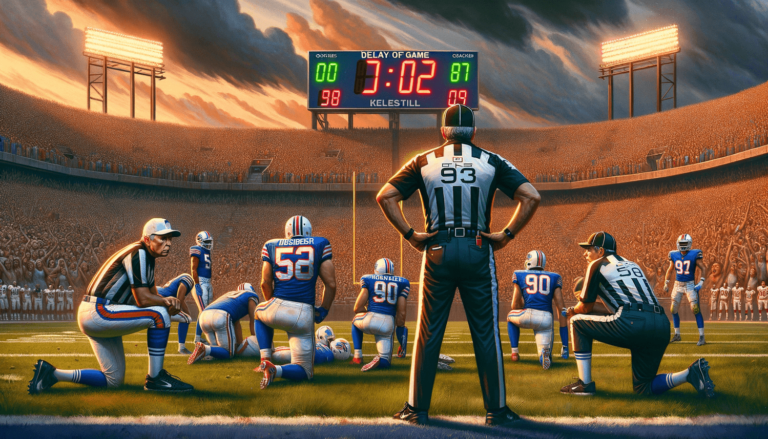
A Delay of Game in football occurs when the offensive team fails to snap the ball before the play clock expires, resulting in a 5-yard penalty. This rule ensures that the game proceeds in a timely manner and prevents teams from excessively stalling.
Understanding Delay of Game in Football
A Delay of Game in football is a penalty called against the offensive team when they fail to execute a play within the designated time provided by the play clock. This rule exists to maintain the flow of the game and prevent teams from intentionally stalling.
Play Clock and Its Significance
The play clock, also known as the game clock, is a visible countdown timer displayed on the scoreboard. In the NFL and college football, the play clock is set at 40 seconds which begins counting down immediately after the end of the previous play. Teams must snap the ball before the clock reaches zero to avoid a Delay of Game penalty.
Resetting the Play Clock
In certain situations, the play clock may be reset to 25 seconds. These occur after specific events such as penalties, injuries, and timeouts. When this happens, the offensive team has significantly less time to execute a play, increasing the potential for a Delay of Game penalty.
Consequences of Delay of Game Penalty
When a Delay of Game penalty is called, the offending team is penalized with a 5-yard loss. This pushes the line of scrimmage back and can greatly impact the team’s game strategy. Frequent Delay of Game penalties can hinder a team’s offensive progression and contribute to a struggle to score points.
Exceptions and Avoiding Delay of Game Penalties
It’s essential for teams to manage the play clock effectively, and the quarterback typically bears the responsibility of keeping an eye on the timer. Coaches can also help by signaling plays in promptly to avoid delays. In some cases, a team may opt to intentionally take a Delay of Game penalty if they’re seeking to run more time off the game clock or change field position for a strategic advantage, such as for a punt. However, this must be weighed carefully against the potential negative impact of the resulting penalty yardage.
Recognizing Delay of Game Penalties
Referees play an essential role in spotting and enforcing Delay of Game penalties. They closely monitor the play clock, blowing the whistle and throwing a penalty flag when the clock expires before the ball is snapped. The referee then signals the Delay of Game penalty, clearly communicating the infraction to players, coaches, and spectators.
Special Teams and Delay of Game
While most commonly associated with offensive plays, the Delay of Game penalty is also applicable to special teams. This can happen during field goal attempts, punts, and kickoffs if the team fails to initiate the action within the allotted time. The same 5-yard penalty applies, potentially impacting the team’s kicking strategy and field position.
Defensive Delay of Game
Although rare, defensive Delay of Game penalties can occur when a defensive player deliberately attempts to disrupt the offensive team’s communication or simulate the snap count to provoke an offensive false start. In these cases, the defensive team is penalized 5 yards, moving the line of scrimmage up and benefiting the offense.
Notable Delay of Game Scenarios
While the Delay of Game penalty is generally straightforward, some memorable NFL scenarios have occurred involving this rule. One example includes quarterbacks intentionally taking a Delay of Game penalty to provide their punters more space around the end zone, possibly resulting in better field position for their team after the punt is executed.
Another strategic use of Delay of Game penalties is to force the opposing team to show their defensive or offensive setup before a critical play, allowing the coach and players enough time to reevaluate their approach and call an optimal play against the opponent’s strategy.
Frequently Asked Questions about Delay of Game in Football
Besides understanding the general concept and mechanics of Delay of Game penalities, readers might have further questions. We’ve compiled some commonly asked questions and answers related to this topic for your convenience:
1. How long is the play clock in high school football?
In high school football, the play clock is generally 25 or 40 seconds, depending on the specific rules applied at the state or association level. This time is typically shorter than in the NFL and college football, where the play clock is set to 40 seconds.
2. Are Delay of Game penalties applied in soccer?
While incomparable to the Delay of Game penalty per se in American football, soccer does have its set of rules that penalize time wasting, stalling, or delaying the game. For instance, a goalkeeper holding onto the ball for an excessive amount of time could earn a yellow card for time wasting.
3. What are other common offensive penalties in football?
Besides Delay of Game, other regularly occurring offensive penalties include holding, false start, illegal formation, and offensive pass interference. These penalties carry their own specific yardage consequences and impact on the team’s game play.
4. Can the quarterback legally ‘spike’ the ball to avoid a Delay of Game penalty?
Yes, a quarterback can legally spike the ball into the ground immediately after receiving the snap to stop the game clock in situations where time is of the essence. However, this constitutes an incomplete pass on purpose, which means the team loses a down.
5. Can a team use a timeout to prevent a Delay of Game penalty?
Yes, a team can choose to use a timeout before the play clock expires in order to avoid a Delay of Game penalty. This can buy the offensive team additional time to develop a play or reset their strategy. However, teams should use their timeouts judiciously, as their number is limited throughout the game.
Featured Posts
- No pillar pages found.





